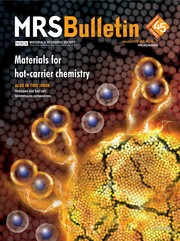Materials for hot-carrier chemistry. The promise of photoexcited hot-electron chemistry (and the complementary hot-hole chemistry) is supported by its application in many important reactions, including CO2 reduction, water splitting, hydrogenation, and coupling reactions, highlighting its potential in achieving high energy-conversion efficiency and product selectivity. Hot-electron chemistry represents a fundamentally different solar energy-conversion mechanism compared to traditional photochemistry. This issue of MRS Bulletin examines the generation and relaxation of hot electrons in typical nanoparticle systems upon light absorption and the flow of hot electrons across the surfaces of the nanoparticles. On the cover, the bottom right image is a photoexcited nanoparticle. The pairs of transparent balls with blue cores represent reactant molecules. The individual transparent balls with blue cores represent the product molecules, which are formed from the interaction of the reactant molecules with hot electrons on the surface of the nanoparticle. See the technical theme that begins on p. 20.
Departments
Society News
Sarah E. Morgan appointed JMR Associate Editor for Polymers and Organic Materials
-
- Published online by Cambridge University Press:
- 10 January 2020, p. 71
-
- Article
-
- You have access
- HTML
- Export citation
Features
Announcements
MRS MOVERS & SHAKERS: Spread the good news!
-
- Published online by Cambridge University Press:
- 10 January 2020, p. 72
-
- Article
-
- You have access
- HTML
- Export citation
Front Cover (OFC, IFC) and matter
MRS volume 45 issue 1 Cover and Front matter
-
- Published online by Cambridge University Press:
- 10 January 2020, pp. f1-f6
-
- Article
-
- You have access
- Export citation
Back Cover (OBC, IBC) and matter
MRS volume 45 issue 1 Cover and Back matter
-
- Published online by Cambridge University Press:
- 10 January 2020, pp. b1-b2
-
- Article
-
- You have access
- Export citation

